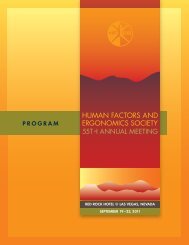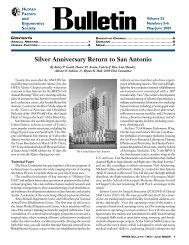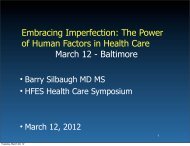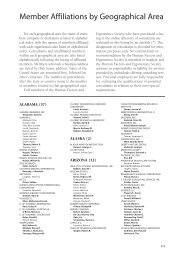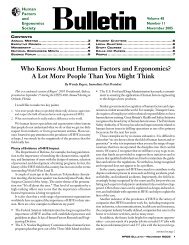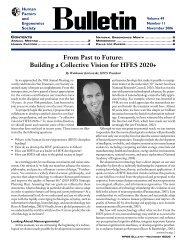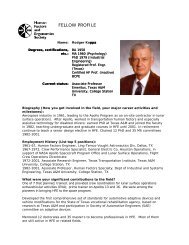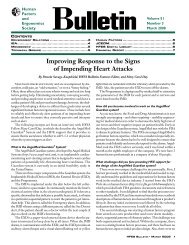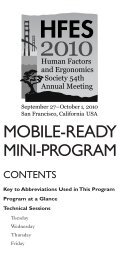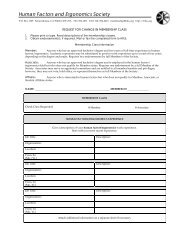A Model for Evaluating Healthcare Simulation Systems
A Model for Evaluating Healthcare Simulation Systems
A Model for Evaluating Healthcare Simulation Systems
Create successful ePaper yourself
Turn your PDF publications into a flip-book with our unique Google optimized e-Paper software.
Erik Prytz, Michael Montano, Rebecca Kennedy, Brittany<br />
Anderson-Montoya, Mark Scerbo<br />
Psychology, Old Dominion University<br />
Andrea Parodi<br />
Virginia <strong>Model</strong>ing, Analysis, and <strong>Simulation</strong> Center, Old<br />
Dominion University<br />
Bob Armstrong<br />
National Center <strong>for</strong> Collaboration in Medical <strong>Model</strong>ing &<br />
<strong>Simulation</strong>, Eastern Virginia Medical School
Laboratory <strong>for</strong> Investigation, Validation,<br />
and Verification of Emerging Simulators<br />
• LIVES Lab
To establish a functional model to<br />
evaluate healthcare simulation systems<br />
based on sound scientific principles,<br />
national and international standards, and<br />
industry-established best practices.<br />
To in<strong>for</strong>m the greater medical community<br />
of the effectiveness, ease of use,<br />
consumer satisfaction, reliability, validity,<br />
and durability of medical simulators and<br />
simulations.
Established by: National Center <strong>for</strong><br />
Collaboration in Medical <strong>Model</strong>ing &<br />
<strong>Simulation</strong> (NCCMMS)<br />
NCCMMS is a joint venture<br />
• Eastern Virginia Medical School (EVMS)<br />
• Old Dominion University’s Virginia <strong>Model</strong>ing,<br />
Analysis, and <strong>Simulation</strong> Center (VMASC)
Multidisciplinary:<br />
• clinical medicine and nursing,<br />
• professional graduate medical and healthcare<br />
education,<br />
• bioengineering,<br />
• human factors psychology,<br />
• computer science,<br />
• modeling, simulation, and visualization,<br />
• and others.
One goal: Apply Human Factors assessment<br />
methods to medical and healthcare training<br />
simulators and simulations<br />
Assessment process comparable to that<br />
used <strong>for</strong> medical devices intended <strong>for</strong><br />
direct patient use<br />
Methods include<br />
• Rigorous experimental design<br />
• Test cases<br />
• Validated questionnaires<br />
• Per<strong>for</strong>mance metrics<br />
• Established standards and guidelines
ANSI/AAMI HE75<br />
• HF Engineering: Design of medical devices<br />
ANSI/HFES 200<br />
• HF Engineering of software user interfaces<br />
ANSI/AAMI/IEC 62366<br />
• Application of usability engineering to medical<br />
devices<br />
ISO/IEC 25010<br />
• <strong>Systems</strong> and software quality evaluation<br />
Among others…
Assess current healthcare simulators that<br />
exists on the marketplace<br />
Define an evaluation process based on<br />
current standards (e.g., the ISO25010)
The evaluation process:<br />
Addresses the purpose and requirements of<br />
the simulator<br />
Establishes a quality model<br />
Employs hierarchical/cognitive task<br />
analyses (HTAs & CTAs)<br />
• For the training task<br />
• For the simuland task<br />
Includes Subject-Matter Expert (SME)<br />
interviews<br />
Addresses best clinical practices<br />
Includes user testing
Initial evaluation: Virtual I.V. Self-Directed<br />
Learning System<br />
Two goals:<br />
• To test the established evaluation process<br />
• To deliver a comprehensive report to potential<br />
users and consumers of the system that may<br />
in<strong>for</strong>m purchasing decisions and system usage
Established Quality <strong>Model</strong><br />
• System purpose<br />
• User population<br />
• SME population<br />
• Functionality<br />
• Reliability<br />
• Usability<br />
• Efficiency<br />
• Maintainability<br />
• Portability
Usability tests:<br />
• HTA/CTA<br />
• Standards checklists<br />
• SME interviews<br />
• User testing<br />
• Questionnaires<br />
• Per<strong>for</strong>mance metrics<br />
• Unstructured user interviews
Initial Results:<br />
• Interface easy to use, but some problem areas<br />
(e.g., icon design) identified<br />
• Follows most standards, but falls short on fault<br />
tolerance and customizability<br />
• SMEs and users agreed on the usefulness of the<br />
system, but noted some problems (irreversible<br />
errors, lack of flexibility, poor representation of<br />
psychomotor tasks)<br />
• May properly train procedural skills, but not<br />
social or psychomotor skills
Process Evaluation<br />
• The evaluation demonstrated the utility of the<br />
established process<br />
• Areas of improvement were identified and<br />
addressed<br />
• Established working procedures among<br />
members of the multidisciplinary team<br />
• First step to establishing a body of<br />
simulation/simulator evaluations
LIVES Lab is a new entity that will work to<br />
in<strong>for</strong>m the greater user community of<br />
healthcare and medical simulators and<br />
simulations.<br />
LIVES will apply scientifically sound testing<br />
procedures derived from established<br />
industry standards with a multidisciplinary<br />
approach<br />
LIVES is an independent entity that does not<br />
produce competing products <strong>for</strong> the<br />
medical simulation market
Dr. Andrea Parodi: aparodi@odu.edu<br />
Dr. Mark Scerbo: mscerbo@odu.edu<br />
Bob Armstrong: armstrrk@evms.edu



